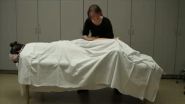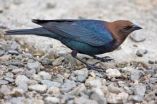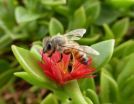(Press-News.org) This news release is available in German.
Our eyes not only enable us to recognise objects; they also provide us with a continuous stream of information about our own movements. Whether we run, turn around, fall or sit still in a car – the world glides by us and leaves a characteristic motion trace on our retinas. Seemingly without effort, our brain calculates self-motion from this "optic flow". This way, we can maintain a stable position and a steady gaze during our own movements. Together with biologists from the University of Freiburg, scientists from the Max Planck Institute of Neurobiology in Martinsried near Munich have now discovered an array of new types of neurons, which help the brain of zebrafish to perceive, and compensate for, self-motion.
When we jog through a forest, the image of the trees appears to move backwards across our retina. This occurs for both eyes in the same direction. If, however, we turn about our own axis, the trees appear to rotate around us. For one eye, this rotation goes from the outside in, and for the other one it goes from the inside out. Our brain processes such large-scale movements in the visual environment, the "optic flow", so that when jogging, for example, we can estimate our speed correctly and do not constantly stumble.
The human brain is, of course, not unique in being able to perceive optic flow. Fish that live in rivers and streams use this capability, for example, to prevent themselves from drifting in the current. Based on the optic flow, the fish corrects its passive drifting through its own swimming. How and where the fish brain carries out these calculations was not previously known.
"We wanted to know how the compensatory movements are triggered and by which neurons," explains Herwig Baier. Together with his department at the Max Planck Institute of Neurobiology, he searches for and describes the neural networks in the brains of zebrafish larvae that control certain types of behaviour. This is no easy task, as, despite its minuscule size, the brain of a 5-mm-long fish larva consists of several hundred thousand neurons. One advantage, however, is that the brain of the fish larva is almost completely transparent. Neurons can thus be observed directly under the microscope without requiring any surgical dissection.
For their experiments, the scientists placed the fish larvae in circular containers, where they saw black-and-white stripes that moved around them. The animals demonstrated different reactions depending on the movement pattern presented. When the stripes moved from back to front for both eyes, the fish swam straight ahead or tried to turn around. However, when the stripes moved around the fish in a clockwise or counter-clockwise direction, the two eyes followed the perceived direction of rotation. The compensatory movements of the entire body (optomotor behaviour) or of the eyes alone (optokinetic behaviour) should make the motion signal on the retina as small as possible – and keep the fish stable in place.
The neurobiologists wanted to identify the neurons while the brain was processing self-motion and initiating optomotor or optokinetic movements. "It was like looking for a needle in a haystack," explains Fumi Kubo, first author of the study. "This would have been completely inconceivable just a few years ago." For her study, Fumi Kubo, who worked in collaboration with Aristides Arrenberg and Wolfgang Driever from the Institute of Biology I at the University of Freiburg and scientists from the Freiburg Cluster of Excellence BIOSS Centre for Biological Signalling Studies, used a new scientific method: the imaging of the entire brain. Thanks to the latest fluorescent dyes and sophisticated genetic techniques, it has recently become possible to visualise the outlines of all neurons in a fish brain. The special feature of this technique, however, is that the dyes change colour when a neuron becomes active.
During the experiment, the heads of the fish with the labelled nervous system were embedded in a gel. The moving striped patterns on the walls of the container gave the animals the impression of self-motion, similar to the sensation triggered in an IMAX cinema. Depending on whether the stripes drifted forward or rotated, the fish followed the patterns with their eyes or beat their tails. Using a two-photon microscope, the scientists were able to observe which neurons reacted to the direction of the moving stripes.
Four direction-selective cell types had previously been identified in the retina. For a long time, scientists had predicted that these cells somehow carry information about optic flow to downstream neurons in the visual brain, which in turn transmitted the commands to the motor centers that control eye and body movements. The neurobiologists have now succeeded in demonstrating the existence of such comparatively simple neuronal connections. They also discovered seven previously unknown cell types responsible for more complex responses to the inputs from both eyes. For example, one type of cell becomes active when both eyes perceive a forward movement but not a clockwise rotation, which would evoke a turn to the right. This finding is remarkable as in both cases, the left eye should detect a movement from the outside in. "So, not only did we find new cell types, we also discovered a possible explanation as to why the fish's brain distinguishes between translational (that is, forward or backward) and rotational (that is, clockwise or counterclockwise) movements," explains Fumi Kubo.
Once the fish were placed back, swimming freely in their tank, the scientists produced a wiring diagram of the cells based on the recorded tasks for the new neuron types and their locations in the brain. Their findings help to provide a better understanding of the processing of movements in the vertebrate brain. However, Fumi Kubo is already thinking about the next stage in the research: "The next challenge will be to prove the proposed connections in the brain."
INFORMATION:
Original publication
Fumi Kubo, Bastian Hablitzel, Marco Dal Maschio, Wolfgang Driever, Herwig Baier und Aristides B Arrenberg
Functional architecture of an optic flow responsive area that drives horizontal eye movements in zebrafish
Neuron, 19 March 2014
How vision makes sure that little fish do not get carried away
Newly discovered types of neurons in the animals' brain help to compensate for self-motion
2014-04-17
ELSE PRESS RELEASES FROM THIS DATE:
Massage therapy improves circulation, eases muscle soreness
2014-04-17
VIDEO:
Massage therapy improves general blood flow and alleviates muscle soreness after exercise, according to a study by researchers at the University of Illinois at Chicago.
Click here for more information.
Massage therapy improves general blood flow and alleviates muscle soreness after exercise, according to a study by researchers at the University of Illinois at Chicago.
The study, reported online in advance of print in the Archives of Physical Medicine and Rehabilitation, ...
Food shortages could be most critical world issue by mid-century
2014-04-17
WASHINGTON, D.C. -- The world is less than 40 years away from a food shortage that will have serious implications for people and governments, according to a top scientist at the U.S. Agency for International Development.
"For the first time in human history, food production will be limited on a global scale by the availability of land, water and energy," said Dr. Fred Davies, senior science advisor for the agency's bureau of food security. "Food issues could become as politically destabilizing by 2050 as energy issues are today."
Davies, who also is a Texas A&M AgriLife ...
Internet use may cut retirees' depression
2014-04-17
Spending time online has the potential to ward off depression among retirees, particularly among those who live alone, according to research published online in The Journals of Gerontology, Series B: Psychological Sciences and Social Sciences. In the article "Internet Use and Depression Among Retired Older Adults in the United States: A Longitudinal Analysis," the authors report that Internet use reduced the probability of a depressed state by 33 percent among their study sample.
Late-life depression affects between 5 and 10 million Americans age 50 and older. This new ...
A cross-section of the universe
2014-04-17
An image of a galaxy cluster taken by the NASA/ESA Hubble Space Telescope gives a remarkable cross-section of the Universe, showing objects at different distances and stages in cosmic history. They range from cosmic near neighbours to objects seen in the early years of the Universe. The 14-hour exposure shows objects around a billion times fainter than can be seen with the naked eye.
This new Hubble image showcases a remarkable variety of objects at different distances from us, extending back over halfway to the edge of the observable Universe. The galaxies in this image ...
Researcher looks at public perceptions around newborn testing
2014-04-17
TORONTO, April 17, 2014—While 94 per cent of Canadians surveyed said they would participate in public health programs that screen newborns for a specific number of genetic conditions, only 80 per cent said they would be willing to participate in screening that would sequence their newborns' genomes.
Most newborns in North America have a "heel prick test" in their first day or two of life in which a tiny amount of blood is taken from their heels and tested for about five to 54 conditions, depending on the state or province. Some conditions commonly tested for include cystic ...
Adrenaline does little to increase patient's survival after cardiac arrest
2014-04-17
TORONTO, April 17, 2014— Giving patients adrenaline after they suffer a cardiac arrest outside of a hospital does not increase their prospects of surviving long-term, according to new research conducted at St. Michael's Hospital.
"The vast number of patients who have a cardiac arrest get adrenaline, which has been the drug recommended in treating cardiac arrest for decades," said Dr. Steve Lin, an emergency physician and trauma team leader at St. Michael's. "Yet, despite advances in medical treatment, long-term survival rates of patients who suffer a cardiac outside a ...
Animal study provides first evidence that gel can prevent multiple virus transmission in vagina/rectum
2014-04-17
NEW YORK (17 April 2014)— Population Council scientists and their partners have found that their proprietary microbicide gel is safe, stable, and can prevent the transmission of multiple sexually transmitted infections (STIs) in both the vagina and rectum in animals: HIV, herpes simplex virus 2 (HSV-2), and human papillomavirus (HPV). The USAID-funded study also provides the first data that the gel is effective against multiple strains of HIV, and has a window of efficacy in the vagina against all three viruses of at least eight hours prior to exposure. A Phase 1 safety ...
Wireless power transfer achieved at 5-meter distance
2014-04-17
Daejeon, Republic of Korea, April 17, 2014 – The way electronic devices receive their power has changed tremendously over the past few decades, from wired to non-wired. Users today enjoy all kinds of wireless electronic gadgets including cell phones, mobile displays, tablet PCs, and even batteries. The Internet has also shifted from wired to wireless. Now, researchers and engineers are trying to remove the last remaining wires altogether by developing wireless power transfer technology.
Chun T. Rim, a professor of Nuclear & Quantum Engineering at KAIST, and his team ...
Fear of the cuckoo mafia
2014-04-17
This news release is available in German. If a restaurant owner fails to pay the protection money demanded of him, he can expect his premises to be trashed. Warnings like these are seldom required, however, as fear of the consequences is enough to make restaurant owners pay up. Similarly, mafia-like behaviour is observed in parasitic birds, which lay their eggs in other birds' nests. If the host birds throw the cuckoo's egg out, the brood parasites take their revenge by destroying the entire nest. Consequently, it is beneficial for hosts to be capable of learning and ...
East African honeybees are safe from invasive pests… for now
2014-04-17
Several parasites and pathogens that devastate honeybees in Europe, Asia and the United States are spreading across East Africa, but do not appear to be impacting native honeybee populations at this time, according to an international team of researchers.
The invasive pests include including Nosema microsporidia and Varroa mites.
"Our East African honeybees appear to be resilient to these invasive pests, which suggests to us that the chemicals used to control pests in Europe, Asia and the United States currently are not necessary in East Africa," said Elliud Muli, senior ...
LAST 30 PRESS RELEASES:
Empty-handed neurons might cause neurodegenerative diseases
Black women hospitalised in USA with blood infection resistant to last-resort antibiotic at increased risk of death
NEC Society Statement on the Watson vs. Mead Johnson Verdict
Lemur’s lament: When one vulnerable species stalks another
Surf clams off the coast of Virginia reappear – and rebound
Studying optimization for neuromorphic imaging and digital twins
ORNL researchers win Best Paper award for nickel-based alloy tailoring
New beta-decay measurements in mirror nuclei pin down the weak nuclear force
Study uncovers neural mechanisms underlying foraging behavior in freely moving animals
Gene therapy is halting cancer. Can it work against brain tumors?
New copper-catalyzed C-H activation strategy from Scripps Research
New compound from blessed thistle promotes functional nerve regeneration
Auburn’s McCrary Institute, ORNL to partner on first regional cybersecurity center to protect the nation’s electricity grid
New UNC-Chapel Hill study examines the increased adoption of they/them pronouns
Groundbreaking study reveals potential diagnostic marker for multiple sclerosis years before symptom onset
Annals of Internal Medicine presents breaking scientific news at ACP’s Internal Medicine Meeting 2024
Scientists discover new way to extract cosmological information from galaxy surveys
Shoe technology reduces risk of diabetic foot ulcers
URI-led team finds direct evidence of ‘itinerant breeding’ in East Coast shorebird species
Wayne State researcher aims to improve coding peer review practices
Researchers develop a new way to safely boost immune cells to fight cancer
Compact quantum light processing
Toxic chemicals from microplastics can be absorbed through skin
New research defines specific genomic changes associated with the transmissibility of the monkeypox virus
Registration of biological pest control products exceeds that of agrochemicals in Brazil
How reflecting on gratitude received from family can make you a better leader
Wearable technology assesses surgeons’ posture during surgery
AATS and CRF® partner on New York Valves: The structural heart summit
Postpartum breast cancer and survival in women with germline BRCA pathogenic variants
Self-administered acupressure for probable knee osteoarthritis in middle-aged and older adults
[Press-News.org] How vision makes sure that little fish do not get carried awayNewly discovered types of neurons in the animals' brain help to compensate for self-motion








